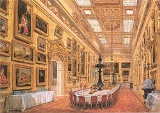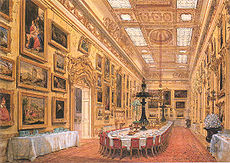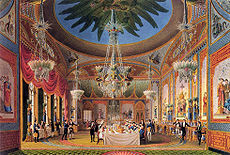
Londonderry House
Encyclopedia

Park Lane (road)
Park Lane is a major road in the City of Westminster, in Central London.-History:Originally a country lane running north-south along what is now the eastern boundary of Hyde Park, it became a fashionable residential address from the eighteenth century onwards, offering both views across Hyde Park...
in the Mayfair
Mayfair
Mayfair is an area of central London, within the City of Westminster.-History:Mayfair is named after the annual fortnight-long May Fair that took place on the site that is Shepherd Market today...
district of London
London
London is the capital city of :England and the :United Kingdom, the largest metropolitan area in the United Kingdom, and the largest urban zone in the European Union by most measures. Located on the River Thames, London has been a major settlement for two millennia, its history going back to its...
, England.
The house was the home to the Irish, titled family called the Stewarts who are better known as the Marquesses of Londonderry.
It remained their London residence until its demolition in 1965.
Brief history
Londonderry House was bought by The Rt. Hon. The 1st Baron Stewart, an Anglo-IrishAnglo-Irish
Anglo-Irish was a term used primarily in the 19th and early 20th centuries to identify a privileged social class in Ireland, whose members were the descendants and successors of the Protestant Ascendancy, mostly belonging to the Church of Ireland, which was the established church of Ireland until...
aristocrat, in 1819 to serve as a home whilst the family stayed in London during the season. Lord Stewart succeeded as The Most Hon.
The Most Honourable
The prefix The Most Honourable is a title of quality attached to the names of marquesses in the United Kingdom. Dukes are The Most Noble or His Grace and peers under the rank of marquess are The Right Honourable. Scottish Feudal Barons and Lairds are The Much Honoured.Certain corporate entities...
The 3rd Marquess of Londonderry in 1822. Although the house was in their possession for more than 150 years, it actually started life before the Londonderry's.
The house was bought by the Sixth Earl of Holdernesse more than half a century before in the 1760s when the Earl
Earl
An earl is a member of the nobility. The title is Anglo-Saxon, akin to the Scandinavian form jarl, and meant "chieftain", particularly a chieftain set to rule a territory in a king's stead. In Scandinavia, it became obsolete in the Middle Ages and was replaced with duke...
is thought to have bought the house next door as well but at a later date. He later joined the two so the house became a double fronted London Mansion
Mansion
A mansion is a very large dwelling house. U.S. real estate brokers define a mansion as a dwelling of over . A traditional European mansion was defined as a house which contained a ballroom and tens of bedrooms...
.
In 1819, as already stated, Lord Stewart (later Marquess of Londonderry
Marquess of Londonderry
Marquess of Londonderry is a title in the Peerage of Ireland. It was created in 1816 for Robert Stewart, 1st Earl of Londonderry. He had earlier represented County Down in the Irish House of Commons. Stewart had already been created Baron Londonderry in 1789, Viscount Castlereagh in 1795 and Earl...
) bought the huge house to become the London home of the family during their long stays in the capital. (The family also owned the palatial Wynyard Park, County Durham
Wynyard Park, County Durham
Wynyard Park, sometimes known as Wynyard Hall is a large country house in County Durham, England. The house used to be the family seat of the Vane-Tempest-Stewart family, Marquesses of Londonderry, an Anglo-Irish aristocratic dynasty, but it was sold in the 1980s.-The house:Designed by Philip Wyatt...
, and Mount Stewart
Mount Stewart
Mount Stewart is an 18th-century house and garden in County Down, Northern Ireland, owned by the National Trust. Situated on the east shore of Strangford Lough, a few miles outside the town of Newtownards and near Greyabbey, it was the home of the Vane-Tempest-Stewart family, Marquesses of...
in the Province of Ulster
Ulster
Ulster is one of the four provinces of Ireland, located in the north of the island. In ancient Ireland, it was one of the fifths ruled by a "king of over-kings" . Following the Norman invasion of Ireland, the ancient kingdoms were shired into a number of counties for administrative and judicial...
in Ireland
Ireland
Ireland is an island to the northwest of continental Europe. It is the third-largest island in Europe and the twentieth-largest island on Earth...
). Soon after this, he began redecorating. The Marquess
Marquess
A marquess or marquis is a nobleman of hereditary rank in various European peerages and in those of some of their former colonies. The term is also used to translate equivalent oriental styles, as in imperial China, Japan, and Vietnam...
spared no expense- shown in his taste of architects: the Wyatt brothers, Benjamin Dean Wyatt
Benjamin Dean Wyatt
Benjamin Dean Wyatt was an English architect. He was the son and pupil of the architect James Wyatt, and the brother of Matthew Cotes Wyatt....
and Philip Wyatt
Philip Wyatt
Philip William Wyatt was an English architect, the youngest son of the architect James Wyatt nephew of Samuel Wyatt, cousin to Sir Jeffry Wyattville....
.
By 1835 the grand transformation was complete and it was the awe of London. The main stairway was meant to outdo that of nearby Lancaster House
Lancaster House
Lancaster House is a mansion in the St. James's district in the West End of London. It is close to St. James's Palace and much of the site was once part of the palace complex...
in nearby St James's. It succeeded in this- it had a large skylight, Rococo
Rococo
Rococo , also referred to as "Late Baroque", is an 18th-century style which developed as Baroque artists gave up their symmetry and became increasingly ornate, florid, and playful...
chandelier and two individual flights of stairs flanking each other. This graceful stairway led into the Grand Ballroom which, rather individually held pictures of the Stewart family men in Garter Robes. Said to have been inspired by the 'Waterloo Chamber' of Apsley House
Apsley House
Apsley House, also known as Number One, London, is the former London residence of the Dukes of Wellington. It stands alone at Hyde Park Corner, on the south-east corner of Hyde Park, facing south towards the busy traffic interchange and Wellington Arch...
, it also outdid that. Around the room were large Marble
Marble
Marble is a metamorphic rock composed of recrystallized carbonate minerals, most commonly calcite or dolomite.Geologists use the term "marble" to refer to metamorphosed limestone; however stonemasons use the term more broadly to encompass unmetamorphosed limestone.Marble is commonly used for...
statues by Canova and chairs in the French style.

Brighton
Brighton is the major part of the city of Brighton and Hove in East Sussex, England on the south coast of Great Britain...
council for the Royal Pavilion
Royal Pavilion
The Royal Pavilion is a former royal residence located in Brighton, England. It was built in three campaigns, beginning in 1787, as a seaside retreat for George, Prince of Wales, from 1811 Prince Regent. It is often referred to as the Brighton Pavilion...
where it can be seen today, along with the Ormonde silver too).
Another elegant room was the tri-partie Drawing Room which held more Londonderry Silver, French furniture, international paintings and painted ceilings with birds.
During World War I the house was used as a military hospital. After World War ICharles Vane-Tempest-Stewart, Viscount Castlereagh
Charles Vane-Tempest-Stewart, 7th Marquess of Londonderry
Charles Stewart Henry Vane-Tempest-Stewart, 7th Marquess of Londonderry, KG, MVO, PC, PC , styled Lord Stewart until 1884 and Viscount Castlereagh between 1884 and 1915, was an Anglo-Irish peer and had careers in both Irish and British politics...
, and his wife, Edith Helen Chaplin
Edith Vane-Tempest-Stewart, Marchioness of Londonderry
Edith Vane-Tempest-Stewart, Marchioness of Londonderry DBE was a noted socialite and philanthropist in the United Kingdom between World War I and World War II.-Family:...
, continued to use the house and entertained extensively. After World War II the house remained in the possession of the Londonderry family.
The Londonderry age was over by the late 1950s due to the huge expense a house of that size would create.
It was sold in 1965 and demolished.
See also
- Mount StewartMount StewartMount Stewart is an 18th-century house and garden in County Down, Northern Ireland, owned by the National Trust. Situated on the east shore of Strangford Lough, a few miles outside the town of Newtownards and near Greyabbey, it was the home of the Vane-Tempest-Stewart family, Marquesses of...
- Wynyard Park, County DurhamWynyard Park, County DurhamWynyard Park, sometimes known as Wynyard Hall is a large country house in County Durham, England. The house used to be the family seat of the Vane-Tempest-Stewart family, Marquesses of Londonderry, an Anglo-Irish aristocratic dynasty, but it was sold in the 1980s.-The house:Designed by Philip Wyatt...
- Plas MachynllethPlas MachynllethPlas Machynlleth was the Welsh residence of the Marquesses of Londonderry, situated in the market town of Machynlleth in Powys , Wales...
- Seaham HallSeaham HallSeaham Hall is now a spa Hotel in County Durham, England. It was once owned by George Henry Robert Charles William Vane-Tempest, 5th Marquess of Londonderry, although for much of his life he lived at Plas Machynlleth, his wife's home in Montgomeryshire....
- Loring HallLoring HallLoring Hall is a Grade II listed building and private mental health care facility in North Cray, Kent.-History:The building, originally called Wollet Hall, was first constructed in 1760, and was between 1811 and 1822 the country residence of British Foreign Secretary Viscount Castlereagh...
Sources and Further Reading
De Courcy, Anne. Society's Queen: The Life of Edith, Marchioness of Londonderry. London: Phoenix, 2004. ISBN 0-7538-1730-6 (Originally published as Circe: The Life of Edith, Marchioness of Londonderry. London: Sinclair-Stevenson, 1992. ISBN 1-85619-363-2)Sykes, Christopher Simon. Private Palaces: Life in the Great London Houses. New York, Viking Penguin Inc 1986. ISBN 0-670-80964-0.

